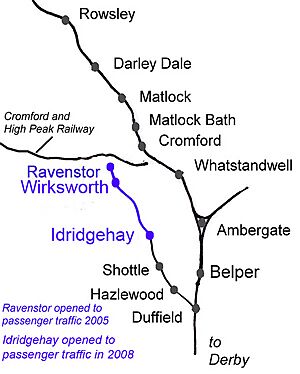Ecclesbourne Valley Railway facts for kids
Quick facts for kids Ecclesbourne Valley Railway |
|
|---|---|
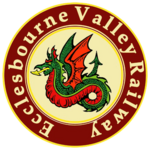 |
|
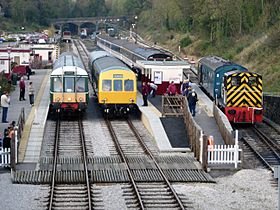
Wirksworth station in 2007
|
|
| Locale | Derbyshire, England |
| Terminus | Ravenstor Duffield |
| Commercial operations | |
| Name | Wirksworth branch |
| Built by | Midland Railway |
| Original gauge | 4 ft 8 1⁄2 in (1,435 mm) standard gauge |
| Preserved operations | |
| Operated by | WyvernRail plc |
| Stations | 5 (to be 6) |
| Length | 9 miles (14 km) |
| Preserved gauge | 4 ft 8 1⁄2 in (1,435 mm) |
| Commercial history | |
| Opened | 1867 |
| Closed to passengers | 1947 |
| Closed | 1964 (goods) 1989 (completely) |
| Preservation history | |
| 1992 | WyvernRail is formed |
| 1996 | Light Rail order granted |
| 1997 | Derby and Wirksworth Railway Association is formed (later to become EVR) |
| 2000 | Volunteers start clearing vegetation from the line |
| 1 October 2002 | Wirksworth reopens and its passenger train services begin |
| 2003 | WyvernRail and Network Rail agrees 15 year lease-purchase deal |
| 2004 | Gorsey Bank reopens and 1⁄2 mile (0.8 km), passenger trains begin |
| 1 September 2005 | Ravenstor opens and 3⁄4 mile (1.2 km) passenger trains on 4% gradient (of the same name) begin |
| 2007 | Iridgehay level crossing reinstated and later reopened |
| 8 March 2008 | Idridgehay reopens and 3+1⁄2 miles (5.6 km) passenger trains begin |
| 8 April 2011 | Duffield reopens and 10 miles (16 km) passenger trains begin |
| 9 August 2014 | Shottle reopens (after more than 65 years out of use) |
| Headquarters | Wirksworth |
| Website | |
| https://www.e-v-r.com/ | |
The Ecclesbourne Valley Railway is a special heritage railway in Derbyshire, England. It is about 9-mile (14.5 km) long. The railway runs passenger trains between Duffield and Wirksworth. Sometimes, trains also go to Ravenstor.
You can get on and off the trains at Duffield. This station is shared with regular trains that go to places like Sheffield and London St Pancras. Ecclesbourne Valley Railway trains use platform 3 at Duffield. The station is in Duffield village, close to shops and cafes.
The railway is named after the River Ecclesbourne. The train tracks follow the river from where it starts to where it joins the River Derwent in Duffield.
There is also a short branch line from Wirksworth. It is about 1⁄2 mile (0.8 km) long and goes up a steep hill to Ravenstor. This is near the National Stone Centre and the High Peak Trail.
The railway uses old steam locomotives and diesel engines. Some famous ones include The Duke (a Bagnall saddle tank engine) and different types of diesel engines.
Contents
History of the Railway
How the Railway Started
The Wirksworth Branch railway line began because of competition between railway companies in the 1800s. People in Wirksworth wanted a train line from Duffield. The Midland Railway company eventually built it. They wanted to extend the line to Rowsley to avoid sharing tracks with their rival, the London and North Western Railway (LNWR).
This is why all the bridges along the line are built in a grand style. They were made big enough for two tracks, even if only one was used.
Building the Line
The railway line is about 8+1⁄2-mile (13.7 km) long. It was planned in 1862 and approved by Parliament in 1863. The line follows the River Ecclesbourne valley. The biggest challenge was the climb into Wirksworth. Some buildings had to be taken down, and there was a lot of work in Duffield.
The line was checked by an expert on September 26, 1867. He said it was ready to open. The railway opened to Wirksworth on October 1, 1867.
The original plan was to extend the line past Wirksworth to Cromford and then to Rowsley. However, the Midland Railway gained full control of the other line, so the extension was never built. This left the Midland Railway with a branch line they weren't sure would be very busy.
How the Railway Operated
The railway helped Wirksworth's limestone business grow. Carrying limestone was the main job of the railway until the mid-1900s. Trains also carried farm products like milk. In 1906, they carried 800,000 imp gal (960,760 US gal; 3,636,872 L) of milk! There were also textile mills in Wirksworth.
The railway had regular passenger trains. There were three, later six, trains from Derby each day, and one on Sundays. There were also two goods trains. By 1939, milk was carried by road instead. During World War II, passenger travel was greatly reduced. Buses also became popular, which meant fewer people used the trains. Passenger trains stopped in 1947.
In the 1950s, people near the line saw a strange sight. A railway carriage seemed to move by itself! This was a test vehicle for new diesel railcars being designed in Derby. When the new "Derby Lightweights" were built, they were tested on this line. One of these original trains, M79900, is now preserved and runs on the line where it was first tested.
Train Accident
On August 25, 1981, a freight train partly went off the tracks. This happened about 300 yards (270 m) south of Wirksworth.
Decline and Closure
Most goods started to be carried by road. But limestone traffic continued, even after the Cromford and High Peak Railway closed in 1967. In the 1980s, new tracks were even put down. However, more and more stone was carried by road. In 1991, the quarries changed owners and no longer needed the railway.
The connection to the main line at Duffield was cut off. But there is hope that the Ecclesbourne Valley Railway might one day buy and use the old goods yard and sidings at Wirksworth. This would give them more space for trains.
The Railway Today
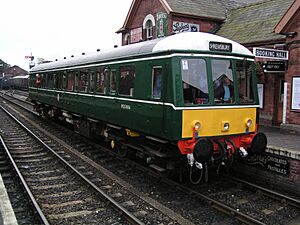
Saving the Railway
In 1996, a company called WyvernRail was given permission to restore and operate the entire line. This permission is called a Light Railway Order.
Wirksworth station reopened in 2002. In 2004, the first 1⁄2 mile (0.80 km) of line between Wirksworth and Gorsey Bank reopened for passenger trains. A new line to Ravenstor opened in 2005. On March 8, 2008, the railway opened more of its line. Trains could then run between Wirksworth and Idridgehay. This added 3+1⁄2 miles (5.6 km) to the line.
In 2003, WyvernRail made a deal to lease and then buy the railway from Network Rail. They bought almost the entire railway early, in May 2005. Only a small part of the Wirksworth station yard is still leased.
In July 2005, WyvernRail also started looking after Duffield station. They helped keep the station tidy and well-maintained.
The line is now ready for passenger trains to run all the way from Wirksworth to Duffield. At Duffield, you can switch to main line trains. There are also stations at Idridgehay and Shottle.
How Trains are Signalled
The railway mainly uses a token system. This means a special key or token must be carried by the driver to show they have permission to be on a section of track. The Wirksworth to Duffield section has one token. The Wirksworth to Ravenstor section has a different token.
There is a special safety device called a trap-point near Wirksworth Station. This protects the Wirksworth-Duffield line. The Wirksworth-Duffield line can also be split into two sections. This is possible because a passing loop was added at Shottle. This usually happens only during special events. It needs two signalmen to control the trains. An old signal box is being restored for use at Shottle. This will allow two trains to run more often.
There were not many physical signals on the line. One old semaphore signal was moved to Shottle station. Another electronic signal at Duffield station warned that it was the end of the line.
Film and TV Appearances
The railway has been used for filming many times:
- An advert for Hellmann's Mayonnaise was filmed here.
- In 2004, the railway was used for the National Geographic Channel show Seconds from Disaster. Old Gatwick Express coaches were used to show a train accident from 1998.
- In 2006, a spot near Wirksworth was used for the ITV drama Mobile.
- In June 2007, Wirksworth was used as a fictional station called 'Lightbourne' in the BBC show Casualty. Trains and a Class 03 engine were used in the story.
Stations Along the Line
Here are the stations of the Ecclesbourne Valley Railway, from north to south:
| Location | Status | Opened | Closed | Notes | Photograph |
|---|---|---|---|---|---|
| Ravenstor | open | 1 September 2005 | This is a new station built by the EVR. | 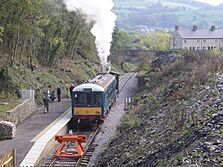 |
|
| Wirksworth | open | 1 October 1867 | 16 June 1947 | The old building was taken down, and new platforms were built. It reopened on October 1, 2002. | 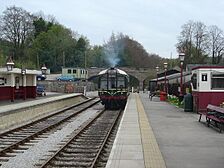 |
| Idridgehay | open | 1 October 1867 | 16 June 1947 | The building is privately owned, but the platform survived. It reopened on March 8, 2008. | 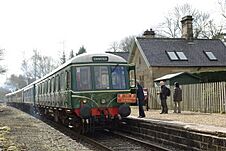 |
| Shottle | open | 1 October 1867 | 16 June 1947 | The building is privately owned, but the platform survived. It reopened on August 9, 2014. |  |
| Hazelwood | closed | 1 October 1867 | 16 June 1947 | The building is privately owned, and the platform was removed. They are thinking about putting the platform back. | 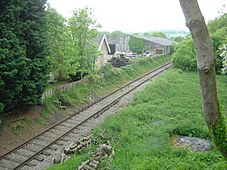 |
| Duffield | open | 1841 | The old buildings were taken down. The branch platform survived. The main platforms are still used by the Derwent Valley Line. It reopened on April 8, 2011. | 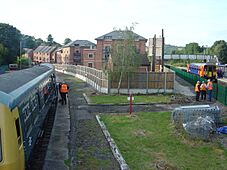 |
Trains and Engines
Steam Locomotives
- Andrew Barclay 0-4-0T 2360 Brian Harrison (Ferrybridge No.3) built in 1954. This engine is currently being repaired. It was taken out of service in 2019. Its boiler has been fixed and is back in the engine. It is expected to be ready soon.
- Hudswell Clarke 0-6-0T No 102 (works number 1884 of 1955) Cathryn built in 1944. This engine is also being restored. Its boiler is fixed and back in place. It is almost ready to run again.
- Bagnall Austerity 0-6-0ST 2746 The Duke built in 1944. This engine is working! It returned to service in December 2023. It has a plain red color.
- BR Standard Class 4 2-6-4T no. 80080 built in 1954. This engine is also working. It is on loan from the Midland Railway – Butterley.
Diesel Trains
Here are some of the diesel trains that run on the line:
- Derby Lightweight: M79900 Iris
- Class 101
- no. E50170
- Class 101: no. E50253
- Class 101: no. E51505
- Class 101: no. E59303
- Class 101: no. M51188
- Class 108
- no. E50599
- no. W50173
- no. W55006
WyvernRail: The Company Behind the Railway
WyvernRail Limited started in 1992. It was created by the community to bring the Duffield to Wirksworth line back to life. The idea was for local people to own and manage the railway.
At first, they planned to lease the line and run trains between Wirksworth and Derby. This was a new way of operating railways called Open Access. However, new railway laws in 1993 made the process very slow.
The railway line was saved because Wirksworth station yard was marked as a Strategic Freight Site. This meant the yard had to be kept for railway use. It made it very hard to close the line completely. In 1990, a train almost removed about 1 mile (1.6 km) of track! Luckily, the work was stopped because there was a chance of new stone traffic. So, the line was put on hold, and it still has this special status today.
After the railway industry changed, WyvernRail found it hard to work with the authorities. But they kept trying. A big success was getting the Light Railway Order for the line in 1996. WyvernRail also changed its plan from leasing to buying the line.
In 1997, the Derby and Wirksworth Railway Association was formed. This group grew slowly. In 2000, it changed its name to the Ecclesbourne Valley Railway Association. Membership grew quickly when volunteers were finally allowed to work on the line.
Things started to move faster for WyvernRail in 2000. The company that owned the tracks, Railtrack, became interested. They helped WyvernRail's volunteers get access to the line. This led to the railway being slowly restored. WyvernRail became a public limited company (plc) and launched a successful share sale in April 2002.


